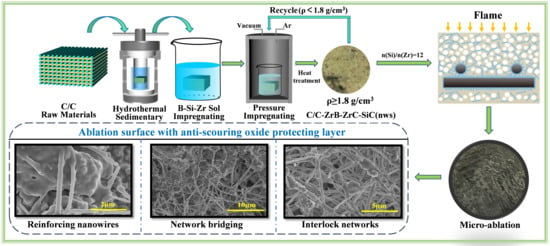Fabrication and Ablation Properties of SiC Nanowires-Network Modified Carbon/Carbon–Ultrahigh Temperature Ceramics Composites
Abstract
:1. Introduction
2. Experimental Section
2.1. Preparation of the C/C-ZrB2-ZrC-SiC(nws) Composites
2.2. Ablation Tests
2.3. Characterization
3. Results and Discussion
3.1. Microstructure and Composition
3.2. Ablation Characteristics
3.3. Ablation Mechanism
4. Conclusions
Author Contributions
Funding
Data Availability Statement
Conflicts of Interest
References
- Savage, G. Carbon-Carbon Composites; Chapman & Hall: London, UK, 1993; pp. 198–209. [Google Scholar]
- Leonard, C.P.; Amundsen, R.M.; Bruce, W.E. Hyper-X Hot structures design and comparison with flight data. In Proceedings of the AIAA/CIRA International Space Planes and Hypersonic Systems and Technologies Conference, AIAA-2005-3438, 1th, Capua, Italy, 16–20 May 2005. [Google Scholar]
- Zhu, S.B.; Zhang, G.X.; Bao, Y.L.; Sun, D.Y.; Zhang, Q.; Meng, X.L.; Hu, Y.; Yan, L.S. Progress in preparation and ablation resistance of ultra-high-temperature ceramics modified C/C composites for extreme environment. Rev. Adv. Mater. Sci. 2023, 62, 20220276. [Google Scholar] [CrossRef]
- Jiao, X.Y.; Tan, Q.; He, Q.C.; Qing, M.C.; Wang, Y.Q.; Yin, X.M. Cyclic ablation behavior of mullite-modified C/C-HfC-SiC composites under an oxyacetylene flame at about 2400 °C. J. Eur. Ceram. Soc. 2023, 43, 4309–4321. [Google Scholar] [CrossRef]
- Pan, X.H.; Niu, Y.R.; Xu, X.T.; Zhong, X.; Shi, M.H.; Zheng, X.B.; Ding, C.X. Long time ablation behaviors of designed ZrC-SiC-TiC ternary coatings for environments above 2000 °C. Corros. Sci. 2020, 170, 108645. [Google Scholar] [CrossRef]
- Hu, C.L.; Pang, S.Y.; Tang, S.F.; Wang, S.J.; Huang, H.T.; Cheng, H.M. Ablation and mechanical behavior of a sandwich-structured composite with an inner layer of Cf/SiC between two outer layers of Cf/SiC-ZrB2-ZrC. Corros. Sci. 2014, 80, 154–163. [Google Scholar] [CrossRef]
- Monteverde, F. The thermal stability in air of hot-pressed diboride matrix composites for uses at ultra-high temperatures. Corros. Sci. 2005, 47, 2020–2033. [Google Scholar] [CrossRef]
- Tang, S.F.; Deng, J.Y.; Wang, S.J.; Liu, W.C.; Yang, K. Ablation behaviors of ultra-high temperature ceramic composites. Mater. Sci. Eng. A 2007, 465, 1–7. [Google Scholar] [CrossRef]
- Jiao, X.Y.; He, Q.C.; Qing, M.C.; Wang, Y.Q.; Yin, X.M. Ablation behavior of C/C-Zr1-xHfxC-SiC composites under an oxyacetylene flame at above 2500 °C. J. Mater. Res. Technol. 2023, 24, 3235–3251. [Google Scholar] [CrossRef]
- Liu, C.X.; Cao, L.X.; Chen, J.X.; Xue, L.; Tang, X.; Huang, Q.Z. Microstructure and ablation behavior of SiC coated C/C-SiC-ZrC composites prepared by a hybrid infiltration process. Carbon 2013, 65, 196–205. [Google Scholar] [CrossRef]
- Jin, X.C.; Fan, X.L.; Lu, C.S.; Wang, T.J. Advances in oxidation and ablation resistance of high and ultra-high temperature ceramics modified or coated carbon/carbon composites. J. Eur. Ceram. Soc. 2018, 38, 1–28. [Google Scholar] [CrossRef]
- Guo, S.Q.; Kagawa, Y.; Nishimura, T.; Chung, D.; Yang, J.M. Mechanical and physical behavior of spark plasma sintered ZrC-ZrB2-SiC composites. J. Eur. Ceram. Soc. 2008, 28, 1279–1285. [Google Scholar] [CrossRef]
- Song, X.M.; Ding, Y.; Zhang, J.M.; Jiang, C.F.; Liu, Z.W.; Lin, C.H.; Zheng, W.; Zeng, Y. Thermophysical and mechanical properties of cubic, tetragonal and monoclinic ZrO2. J. Mater. Res. Technol. 2023, 23, 648–655. [Google Scholar] [CrossRef]
- Liao, X.L.; Li, H.J.; Xu, W.F.; Li, K.Z. Study on the thermal expansion properties of C/C composites. J. Mater. Sci. 2007, 42, 3435–3439. [Google Scholar] [CrossRef]
- Cheng, Y.; Hu, P.; Zhang, W.Z.; Ma, C.; Feng, J.X.; Fan, Q.P.; Zhang, X.H.; Du, S.Y. One-step introduction of ZrC-SiC inside carbon fabric to fabricate high homogeneous and damage-tolerant composite inspired by vibration. J. Eur. Ceram. Soc. 2019, 39, 2251–2256. [Google Scholar] [CrossRef]
- Oana, M.M.; Neff, P.; Valdez, M.; Powell, A.; Packard, M.; Walker, L.S.; Corral, E.L. Oxidation behavior of aerospace materials in high enthalpy flows using an oxyacetylene torch facility. J. Am. Ceram. Soc. 2015, 98, 1300–1307. [Google Scholar] [CrossRef]
- Chen, X.W.; Feng, Q.; Zhou, H.J.; Dong, S.M.; Wang, J.X.; Cao, Y.P.; Kan, Y.M.; Ni, D.W. Ablation behavior of three-dimensional Cf/SiC-ZrB2-ZrC2 composites prepared by a joint process of sol-gel and reactive melt infiltration. Corros. Sci. 2018, 134, 49–56. [Google Scholar] [CrossRef]
- Wang, C.; Xia, L.; Zhong, B.; Yang, H.; Huang, L.N.; Xiong, L.; Huang, X.X.; Wen, G.W. Fabrication and mechanical properties of carbon fibers/lithium aluminosilicate ceramic matrix composites reinforced by in-situ growth SiC nanowires. J. Eur. Ceram. Soc. 2019, 39, 4625–4633. [Google Scholar] [CrossRef]
- Zhang, Z.F.; Sha, J.J.; Dai, J.X.; Zu, Y.F.; Lv, Z.Z. Enhanced fracture properties of ZrB2-based composites by in-situ grown SiC nanowires. Adv. Appl. Ceram. 2019, 118, 137–144. [Google Scholar] [CrossRef]
- Wang, W.; Fu, Q.; Tan, B. Effect of in-situ grown SiC nanowires on the mechanical properties of HfC-ZrB2-SiC modified C/C composites. J. Alloys Compd. 2017, 726, 866–874. [Google Scholar] [CrossRef]
- Wang, C.; Guo, B.; Lu, P.; Xu, Q.; Tu, R.; Kosinova, M.; Zhang, S. Fabrication of porous SiC nanostructured coatings on C/C composite by laser chemical vapor deposition for improving the thermal shock resistance. Ceram. Int. 2022, 48, 12450–12459. [Google Scholar] [CrossRef]
- Chu, Y.H.; Fu, Q.G.; Li, H.J.; Li, K.Z.; Zou, X.; Gu, C.G. Influence of SiC nanowires on the properties of SiC coating for C/C composites between room temperature and 1500 °C. Corros. Sci. 2011, 53, 3048–3053. [Google Scholar] [CrossRef]
- Zhang, J.P.; Fu, Q.G.; Qu, J.L.; Yuan, R.M.; Li, H.J. Blasting treatment and chemical vapor deposition of SiC nanowires to enhance the thermal shock resistance of SiC coating for carbon/carbon composites in combustion environment. J. Alloys Compd. 2016, 666, 77–83. [Google Scholar] [CrossRef]
- Feng, T.; Li, H.J.; Fu, Q.G.; Shen, X.T.; Wu, H. Microstructure and oxidation of multi-layer MoSi2-CrSi2-Si coatings for SiC coated carbon/carbon composites. Corros. Sci. 2010, 52, 3011–3017. [Google Scholar] [CrossRef]
- Zhang, M.Y.; Li, K.Z.; Shi, X.H.; Tan, W.L. Effects of SiC interphase on the mechanical and ablation properties of C/C-ZrC-ZrB2-SiC composites prepared by precursor infiltration and pyrolysis. Mater. Des. 2017, 122, 322–329. [Google Scholar] [CrossRef]
- Wen, S.Q.; Li, K.Z.; Song, Q.; Shan, Y.C.; Li, Y.Y.; Li, H.J.; Ma, H.L. Enhancement of the oxidation resistance of C/C composites by depositing SiC nanowires onto carbon fibers by electrophoretic deposition. J. Alloys Compd. 2015, 618, 336–342. [Google Scholar] [CrossRef]
- Weng, Y.Q.; Yang, X.; Chen, F.X.; Fang, C.Q.; Zhang, X.X.; Shi, A.H.; Huang, Q.Z. Ablative property and mechanism of SiC-CuxSiy modified C/C-ZrC composites prepared by a rapid method. J. Eur. Ceram. Soc. 2023, 43, 4602–4615. [Google Scholar] [CrossRef]
- Ouyang, H.B.; Li, C.Y.; Huang, J.F.; Cao, L.Y.; Fei, J.; Lu, J.; Xu, Z.W. Self-healing ZrB2–SiO2 oxidation resistance coating for SiC coated carbon/carbon composites. Corros. Sci. 2016, 110, 265–272. [Google Scholar]
- Yang, X.; Huang, Q.Z.; Su, Z.A.; Chang, X.; Xue, L.; Zhong, P.; Li, J. Ablative property and mechanism of C/C-ZrB2-ZrC-SiC composites reinforced by SiC networks under plasma flame. Corros. Sci. 2016, 107, 9–20. [Google Scholar]
- Xie, X.M.; Tang, X.; Su, Z.A.; Liao, J.J.; Yang, C.; Huang, Q.Z. Oxidation and ablation behaviours of a SiCnw@SiC-Si coating fabricated for carbon-fibre-reinforced carbon-matrix composites via thermal evaporation and gaseous silicon infiltration. Ceram. Int. 2023, 49, 9130–9137. [Google Scholar] [CrossRef]
- Xie, A.L.; Zhang, B.; Ge, Y.C.; Peng, K.; Xu, P.; Wang, X.D.; Feng, Z.R.; Yi, M.Z.; Zhou, Z. Effect of the incorporation of SiC nanowire with double protective layers on SiC coating for C/C composites. J. Eur. Ceram. Soc. 2023, 43, 4636–4644. [Google Scholar] [CrossRef]
- Liu, C.Q.; Yuan, X.X.; Wang, W.T.; Liu, H.L.; Li, C.X.; Wu, H.; Hou, X.H. In-situ fabrication of ZrB2-ZrC-SiCnws hybrid nanopowders with tuneable morphology SiCnws. Ceram. Int. 2022, 48, 4055–4065. [Google Scholar] [CrossRef]
- Liu, C.Q.; Zhang, L.Y.; Li, C.X.; Wu, H.; Hou, X.H. Preparation of ZrB2-ZrC-SiC-ZrO2 nanopowders with in-situ grown homogeneously dispersed SiC nanowires. Mater. Des. 2020, 196C, 109186. [Google Scholar] [CrossRef]
- Zhuang, L.; Fu, Q.G.; Li, H.J. SiCnw/PyC core-shell networks to improve the bonding strength and oxyacetylene ablation resistance of ZrB2-ZrC coating for C/C-ZrB2-ZrC-SiC composites. Carbon 2017, 124, 675–684. [Google Scholar] [CrossRef]
- Liu, C.Q.; Chang, X.J.; Wu, Y.T.; Wang, X.F.; Hou, X.H. Effect of SiC content on microstructure evolution of ZrC-ZrB2-SiC ceramic in sol-gel process. Vacuum 2020, 177, 109430. [Google Scholar] [CrossRef]
- Huang, D.; Zhang, M.; Huang, Q.; Wang, L.; Xue, L.; Tang, X.; He, K. Ablation mechanism of C/C-ZrB2-ZrC-SiC composite fabricated by polymer infiltration and pyrolysis with preform of Cf/ZrB2. Corros. Sci. 2015, 98, 551–559. [Google Scholar] [CrossRef]
- Cao, L.; Bai, Z.; Huang, J.; Ouyang, H.; Wu, J. Ablation properties of Cf/C-SiC-MoSi2 composites: Effects of hydrothermal penetration temperature. J. Alloys Compd. 2017, 703, 45–55. [Google Scholar] [CrossRef]
- Ouyang, H.B.; Zhang, Y.L.; Li, C.Y.; Li, G.B.; Huang, J.F.; Li, H.J. Effects of ZrC/SiC ratios on mechanical and ablation behavior of C/C–ZrC–SiC composites prepared by carbothermal reaction of hydrothermal co-deposited oxides. Corros. Sci. 2020, 163, 108239. [Google Scholar] [CrossRef]
- SChen, A.; Hu, H.F.; Zhang, Y.D.; Zhang, C.R.; Wan, Q.K. Effects of high-temperature annealing on the microstructure and properties of C/SiC-ZrB2 composites. Mater. Des. 2014, 53, 791–796. [Google Scholar]
- Huang, D.; Zhang, M.Y.; Huang, Q.Z.; Wang, L.P.; Tong, K. Mechanical property, oxidation and ablation resistance of C/C-ZrB2-ZrC-SiC composite fabricated by polymer infiltration and pyrolysis with preform of Cf/ZrB2. J. Mater. Sci. Technol. 2017, 33, 481–486. [Google Scholar] [CrossRef]
- Telle, R.; Greffrath, F.; Prieler, R. Direct observation of the liquid miscibility gap in the zirconia-silica system. J. Eur. Ceram. Soc. 2015, 35, 3995–4004. [Google Scholar] [CrossRef]
- Konijn, B.J.; Sanderink, O.B.J.; Kruyt, N.P. Experimental study of the viscosity of suspensions: Effect of solid fraction, particle size and suspending liquid. Powder Technol. 2014, 266, 61–69. [Google Scholar] [CrossRef]
- Fluegel, A. Glass viscosity calculation based on a global statistical modelling approach. Glass Technol. Eur. J. Glass Sci. Technol. Part A 2007, 48, 13–30. [Google Scholar]

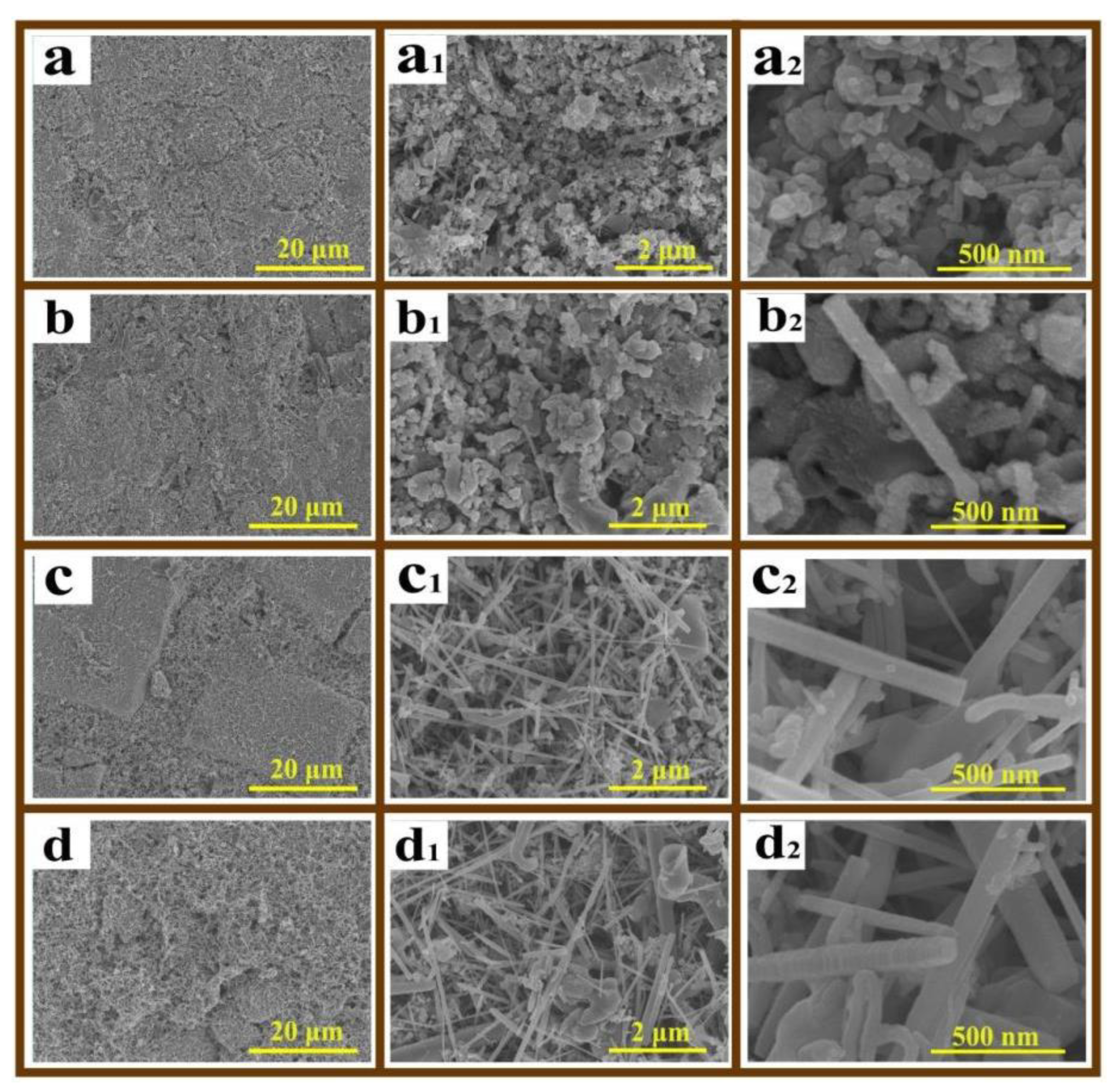
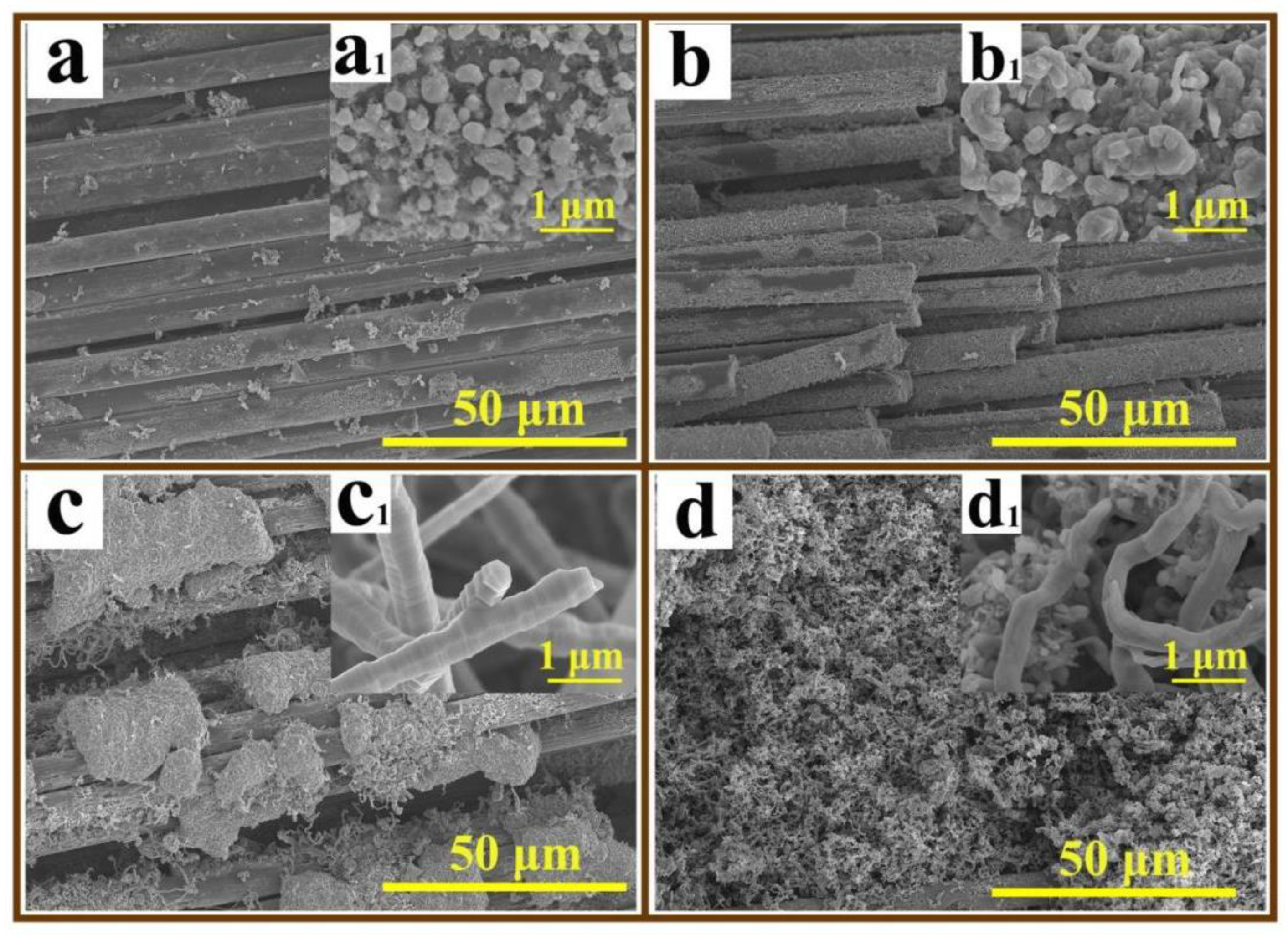
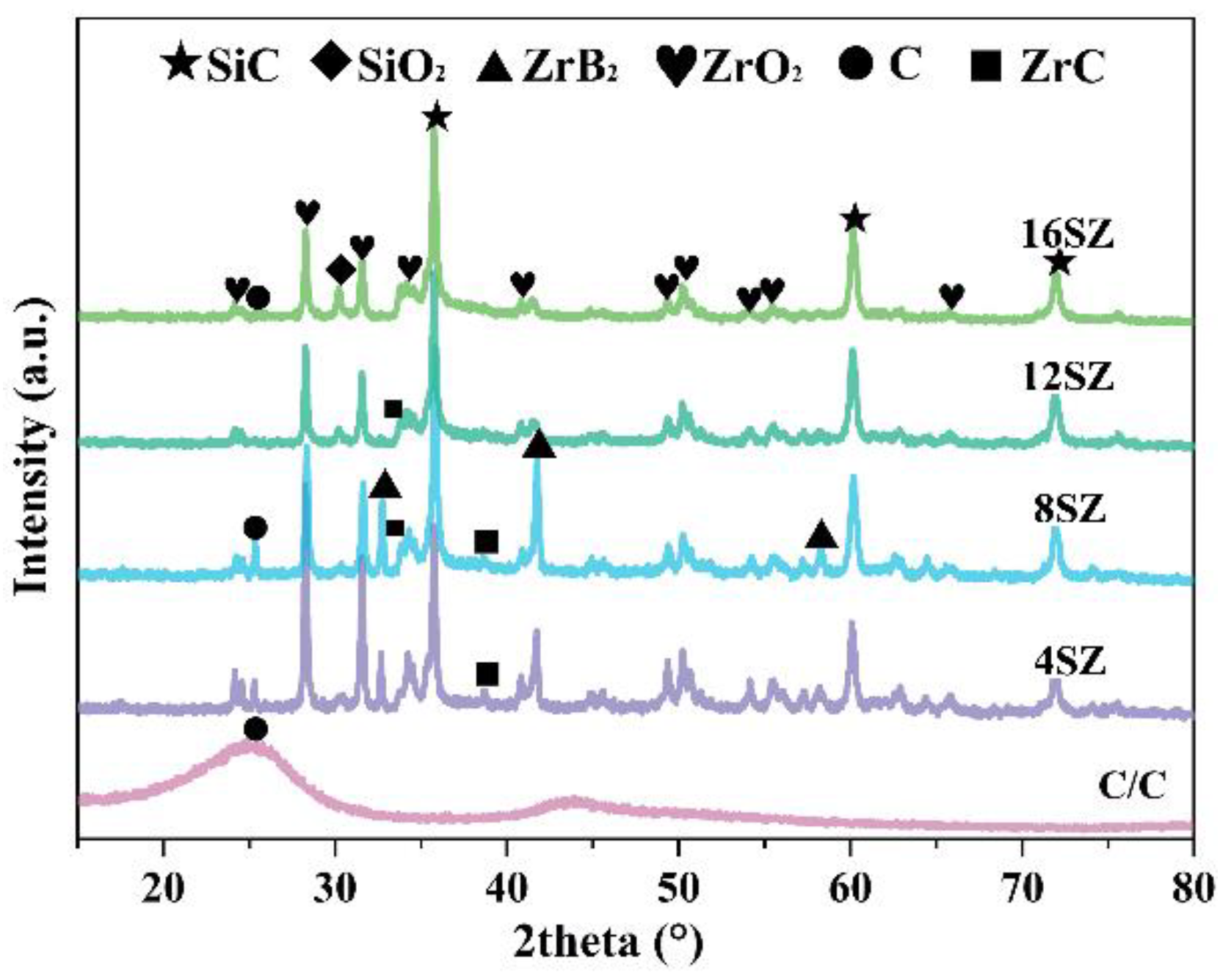





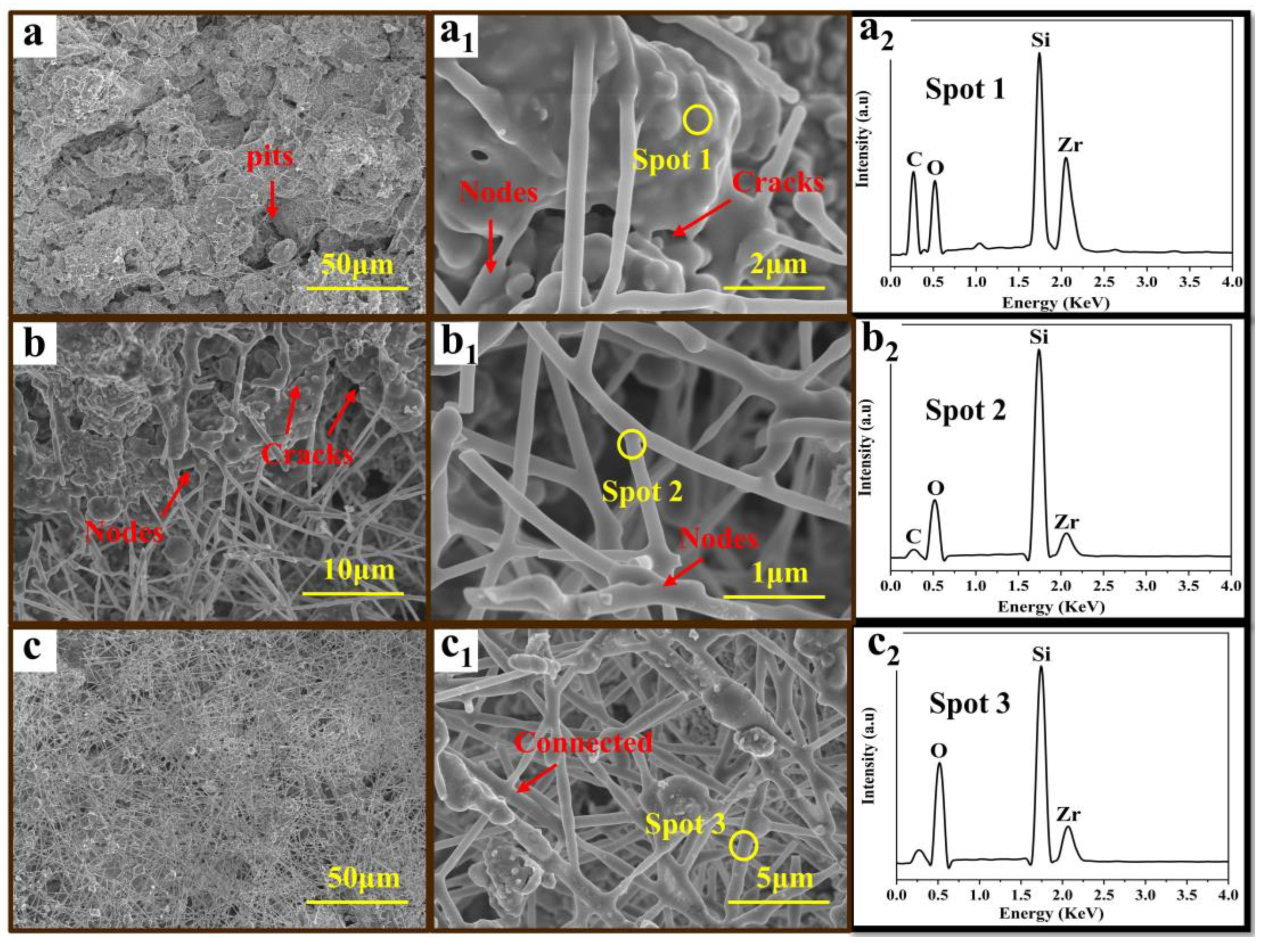


| Samples | n(Si)/n(Zr) | Linear Ablation Rate (Rl, um·s−1) | Standard Deviation of Rl | Mass Ablation Rate (Rm, mg·cm−2·s−1) | Standard Deviation of Rm |
|---|---|---|---|---|---|
| 4SZ | 4 | 0.84 | 0.04 | 1.8 | 0.90 |
| 8SZ | 8 | 0.69 | 0.10 | 0.91 | 0.11 |
| 12SZ | 12 | 0.08 | 0.05 | 0.11 | 0.06 |
| 16SZ | 16 | 0.76 | 0.06 | 0.76 | 0.10 |
Disclaimer/Publisher’s Note: The statements, opinions and data contained in all publications are solely those of the individual author(s) and contributor(s) and not of MDPI and/or the editor(s). MDPI and/or the editor(s) disclaim responsibility for any injury to people or property resulting from any ideas, methods, instructions or products referred to in the content. |
© 2024 by the authors. Licensee MDPI, Basel, Switzerland. This article is an open access article distributed under the terms and conditions of the Creative Commons Attribution (CC BY) license (https://creativecommons.org/licenses/by/4.0/).
Share and Cite
Chen, L.; Wu, Y.; Wang, W.; Yuan, X.; Liu, C.; Li, C. Fabrication and Ablation Properties of SiC Nanowires-Network Modified Carbon/Carbon–Ultrahigh Temperature Ceramics Composites. J. Compos. Sci. 2024, 8, 108. https://doi.org/10.3390/jcs8030108
Chen L, Wu Y, Wang W, Yuan X, Liu C, Li C. Fabrication and Ablation Properties of SiC Nanowires-Network Modified Carbon/Carbon–Ultrahigh Temperature Ceramics Composites. Journal of Composites Science. 2024; 8(3):108. https://doi.org/10.3390/jcs8030108
Chicago/Turabian StyleChen, Long, Yuanting Wu, Wanting Wang, Xiaoxiao Yuan, Changqing Liu, and Chengxin Li. 2024. "Fabrication and Ablation Properties of SiC Nanowires-Network Modified Carbon/Carbon–Ultrahigh Temperature Ceramics Composites" Journal of Composites Science 8, no. 3: 108. https://doi.org/10.3390/jcs8030108





